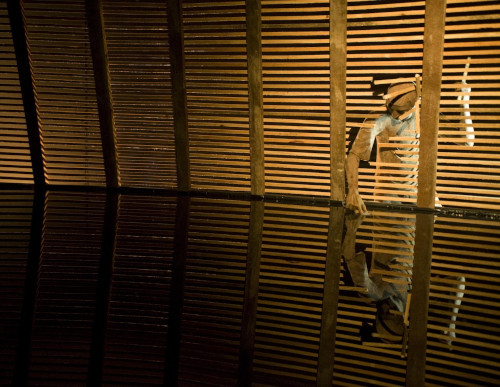You have shown in several exhibitions around the world pictures by "states of mind" there are differences between the look of a European and an Asian? Or not really?
NM : I do think so, I notice that the images are very open and ambiguous , because when one 's looking for them to create a story, usually in the context of exhibition or gallery, or when I show my work publicly or I show it to my closest friends, I notice that they analyze the image and build a story around it is different of the observer's head, is a fiction that in turn they create around the image and that is more interesting than the reality. If there is a difference ? It has to do merely with the observer cannot tell that there be a Western or Asian standart, depends on the person at that time and not so much with the culture .
Let's talk about " from Russia with love " which is another reflection on Russian culture, in particular , their symbols . What drew you to this subject ?
NM : It was a different work, because it was the first thing I did that was more politicized and that is not the intent of these artistic work, which are usually personal. Furthermore , it is not a topic that I had devoted much time to think, but happen during a trip through the eastern countries, was in Portugal and made this trip with friends and what we realized is the size of the country geographically, Russia is immense and at the same time its so closed in social context, would almost facist and saw enormous parallels with the situation that Portugal lived with the regime of dictatorship and during the trip we were questioned by the Russians themselves where we came from and what it was like our country and this was the comparison, so these images and this project was a question, almost an ironic way of how I saw Russia, was an installation concept, in addition to a video karaoke style in which the song sung was from the James Bond saga, then there were the pictures.
Another of your photographic work , which reflects the emotional states was "what remains ", but in this case you did photos of structures and landscapes, why?
NM : This project follows the logic of what were talking about , but is a set of smaller images and diversify more to expose in Almada and yes, this is really connected with this project that is " state of mind" and that in some way, what happens often is that I have images of people and others that are just landscapes or interior spaces. And in a way it's funny, this series "what remains " had to do with it, something left to be completed , the case also has to do with question of human relations, what is this of give time to people? And give us time ? How does that transposes to the image ? Has a more melancholy side that I might approach this time.
After that you made a conceptual work quickly Falling from a dream, with another photographer, how this partnership come about? What attracted you to this project ?
NM: It was very interesting to do a project in parallel with a person that is very close to me Carla Fragata, who is a photographer and everything came across thru a conversation, not always direct or related project but with another type of digrations and then there was this need to create a project together and then there was an exchange of ideas and in which we developed a fictional image, we created a characterization, where it came from, how it felt and did a mini casting, with two women and two men who represented this character was and how Eve, it was a conceptual project photographed very quickly, was done in two days.
The choice of black and white was something instinctive ?
NM: Yes, it was instinctive, first because it has to do with my eyes when I look through the machine, I like to think in black and white, like the contrast. Even in terms of photography itself, with analog, or make the choice between a movie in black and white, or color, my choice is always the first. It's not something I feel conditioned, is something more familiar .
The last work " come to thy kingdom " why you choose charity boxes in concrete?
NM : Actually, it was something that came to me, was confronted with the issue in a way let's say ridiculous, was waiting for a person, in Alvalade, while waiting I decided to enter the Church of Alvalade and noticed the different alms boxes were many, so I decided to photograph them and I do not remember how many , but it will be twenty, I found it almost violent to anyone visiting this space and then the religious point of view as balanced. I found this interesting and at the time come an opportunity to develop a project in an area that I really like that is Cañarte, which is an association of arts and I could work with them and decided to that, was very specific because it emerged with the space that I had at my disposal and ended up doing an installation in which I used marble tables covered with apples and put a box where the I asked the visitor to make a wish and place it in the box and at the end I read all the desires of the visitors. "Come Thy kingdom " is a reflection on religion and on rituals that have not been questioned by us on our day-to-day. I wanted to stimulate a ritual in the visitor of the exhibition, with a different message, freer , less conditioning.
You considered an artist conceptualou a mere archivist of images?
NM : I consider myself a conceptualist because I cannot imagine doing a work without thinking deeply on it, live with that project and has to make sense, if not, I do not continue to question myself and probably never happens, or be visible . Must be conceptual, to be thought of and that has something for people to look at and put themselves some questions.











